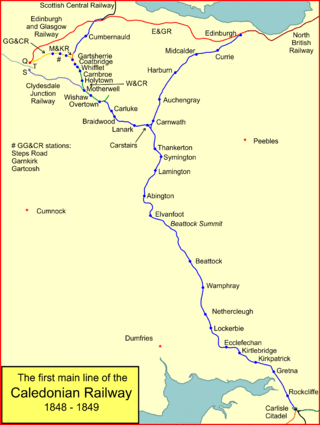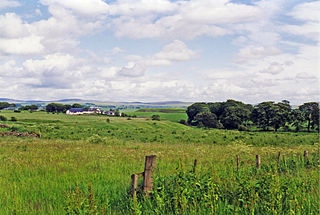Related Research Articles
The Edinburgh and Glasgow Railway was authorised by Act of Parliament on 4 July 1838. It was opened to passenger traffic on 21 February 1842, between its Glasgow Queen Street railway station and Haymarket railway station in Edinburgh. Construction cost £1,200,000 for 46 miles (74 km). The intermediate stations were at Corstorphine, Gogar, Ratho, Winchburgh, Linlithgow, Polmont, Falkirk, Castlecary, Croy, Kirkintilloch and Bishopbriggs. There was a ticket platform at Cowlairs. The line was extended eastwards from Haymarket to North Bridge in 1846, and a joint station for connection with the North British Railway was opened on what is now Edinburgh Waverley railway station in 1847.
The Bathgate and Coatbridge Railway, also known as the "New Monkland Line", was built by Monkland Railways. It opened on 28 July 1863. The line was absorbed into the Edinburgh and Glasgow Railway on 31 July 1865. The following day, the line became part of the North British Railway.

The ruins of the Wilsontown Ironworks are located near the village of Forth in Lanarkshire in Scotland, approximately 23 miles (37 km) to the south east of Glasgow. The works were founded by the three Wilson brothers in 1779, and operated until 1842. The works had two blast furnaces, and in 1790 a forge was added. Later a rolling and slitting mill and additional forging hammers were installed. This increased the capacity of the works to 40 long tons (41 t) of manufactured iron per week. In its heyday the works employed 2,000 people. The village later had a railway branch line from Wilsontown to Auchengray railway station on the Caledonian Railway. This remained open for some years after the demise of the iron works and served several collieries in the area.
The Wishaw and Coltness Railway was an early Scottish mineral railway. It ran for approximately 11 miles from Chapel Colliery, at Newmains in North Lanarkshire connecting to the Monkland and Kirkintilloch Railway near Whifflet, giving a means of transport for minerals around Newmains to market in Glasgow and Edinburgh.

The Caledonian Railway main line in Scotland connected Glasgow and Edinburgh with Carlisle, via Carstairs and Beattock.
The Monkland Railways was a railway company formed in 1848 by the merger of three "coal railways" that had been built to serve coal and iron pits around Airdrie in Central Scotland, and connect them to canals for onward transport of the minerals. The newly formed company had a network stretching from Kirkintilloch to Causewayend, near Linlithgow. These coal railways had had mixed fortunes; the discovery of blackband ironstone and the development of the iron smelting industry around Coatbridge had led to phenomenal success, but hoped-for mineral discoveries in the moorland around Slamannan had been disappointing. The pioneering nature of the railways left them with a legacy of obsolete track and locomotives, and new, more modern, railways were being built around them.
The Rutherglen and Coatbridge Railway was a railway line in Scotland built by the Caledonian Railway to shorten the route from the Coatbridge area to Glasgow. It opened in 1865. It was later extended to Airdrie in 1886, competing with the rival North British Railway. Soon after a further extension was built from Airdrie to Calderbank and Newhouse.

Morningside is a small village in North Lanarkshire, Scotland. It is located around 3⁄4 mile (1.2 km) south of Newmains, and 2+1⁄4 miles (3.6 km) east of Wishaw. Morningside's population is 1,090 people. It is a former coal mining village, and formerly had two railway stations. Today, Morningside mainly consists of a modern housing estate with more older houses along the main road.
The Wilsontown, Morningside and Coltness Railway was a railway opened in 1845, primarily for mineral traffic, although a passenger service was run sporadically. The line ran from a junction with the Wishaw and Coltness Railway at Chapel, to Longridge, in South Central Scotland, and it was extended to Bathgate in 1850 after takeover by the Edinburgh and Glasgow Railway. It was built to open up further coal deposits and to connect the Wilsontown Ironworks, although it did not actually reach Wilsontown. In common with the other "coal railways" with which it connected, it adopted the track gauge of 4 ft 6 in, often referred to as Scotch gauge.
The Caledonian Railway lines to Edinburgh started with the main line that reached Edinburgh in 1848 as part of its route connecting the city with Glasgow and Carlisle. The potential of the docks at Granton and Leith led to branch line extensions, and residential development encouraged branch lines in what became the suburbs of Edinburgh. In 1869 a line was opened from Carfin through Shotts giving the Caledonian a shorter route between Glasgow and Edinburgh.

Longridge railway station was the original terminus of the Wilsontown, Morningside and Coltness Railway (WM&CR) that served the nearby village of Longridge in West Lothian and it was also referred to as Eastern station and was 8 miles 50 chains (13.9 km) from Morningside station.
The Caledonian Railway branches in North Lanarkshire built on the Caledonian Railway main line, which opened in 1848. In the following years the considerable increase of iron production and coal extraction in North Lanarkshire led to a progressive expansion of branch lines in the area between the eastern margin of Glasgow and Bellside in the east, and between Coatbridge, Airdrie and Motherwell. Mineral traffic was dominant and for some years passenger operation followed the construction of some of the mineral connections. In 1861 the Rutherglen and Coatbridge line was opened, extended later to Airdrie, rivalling the established Monkland Railways route. In 1869 the connection from Cleland to Midcalder was opened, connecting mineral sites but also forming a new passenger route to Edinburgh.
Davies Dyke railway station or Daviesdyke railway station was a station on the Wilsontown, Morningside and Coltness Railway (WM&CR) that served the rural area of Davies Dyke near Allanton in Lanarkshire, Parish of Cambusnethan. The station was located 1 miles 60 chains east of Morningside railway station.

Crofthead railway station or Fauldhouse and Crofthead was a station on the Wilsontown, Morningside and Coltness Railway (WM&CR) that served the area of Crofthead and its miners rows, Greenburn and Gowanbrae near Fauldhouse in West Lothian. The station was located 7 miles 40 chains east of Morningside railway station.

Wilsontown railway station was the passenger terminus of the three and three quarter mile long Wilsontown Branch that ran from a bay platform at Auchengray railway station and served the nearby village of Wilsontown in Lanarkshire and several collieries. The only other station on the line was at Haywood, standing two miles from Auchengray on a double track section of the line. Apart from the collieries this was a mainly farming district at the times of the railway's construction.

Haywood railway station was the only intermediate station on the three and three quarter mile long Wilsontown Branch that ran from a bay platform at Auchengray railway station and served the mining village of Haywood and also Wilsontown at the passenger line terminus in Lanarkshire. Several collieries were also served via mineral lines.
Turnhouse railway station served the suburb of Turnhouse, Edinburgh, Scotland from 1897 to 1930 on the Forth Bridge Connecting Lines of the North British Railway.
Morningside railway station served the village of Morningside, North Lanarkshire, Scotland from 1844 to 1930 on the Wishaw and Coltness Railway.
Newmains railway station served the village of Newmains, North Lanarkshire, Scotland from 1867 to 1930 on the Cleland to Morningside Line.
Blackhall railway station served the town of Shotts, North Lanarkshire, Scotland, from 1864 to 1893 on the Wilsontown, Morningside and Coltness Railway.